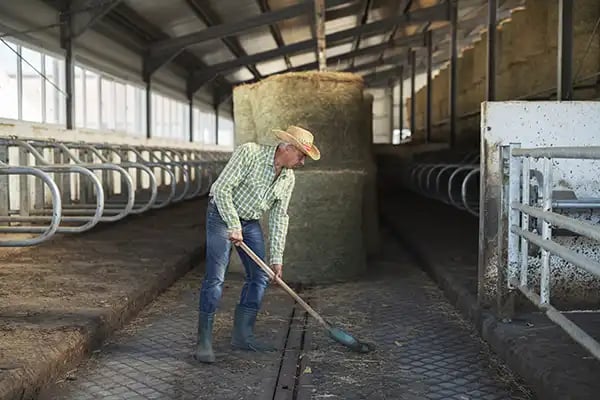
Over the past 30 years, Herculite personnel have built relationships with hundreds of producers and visited dozens of sites, and through that process, discovered a few simple practices to help extend your curtain's life. This article aims to share some basic, easy-to-implement “best practices” that can extend your curtain's life, save money, and increase profit.
Installation Tips
Install the curtain when the temperature is above 40 degrees Fahrenheit.
While Herculite curtain fabrics are rated to withstand cold temperatures below -30 degrees Fahrenheit, that does not necessarily mean it is good to fold, roll, crumple, or aggressively handle the material at those cold temperatures. As a best practice, install curtains when the temperature is above 40 degrees Fahrenheit to prevent premature damage to the material during installation.
During installation of the curtain, avoid nailing through the stitch of the hem.
A common practice during installation is that users nail gravity-drop curtains up while the pipe is being put into the hem, and the roping system is being installed to raise or lower the curtain. On a rare occasion, a hem has failed because while nailing the material up, the nail pierces the thread used to sew the stitch, ultimately causing the hem to unravel. Simply keeping the nail above or below the stitch line will prevent this kind of damage from occurring.
Always use a rope to prevent the curtain from billowing in high winds.
We all understand the power of wind, and without proper rope guards, your 200-foot curtain can gather wind like a sail. A rope system like the one in the adjacent photograph should be used to prevent extreme strain on the curtain. The rope on the facility's exterior will prevent the curtain from billowing out, and the chicken wire used to frame the inside will prevent the curtain from hitting the barn or house, limiting abrasive damage.
Secure the ends of the curtain on-site with tape, roofing staples, or adhesive.
Stitch lines will unravel once the thread has been compromised, and you can cut the curtain to length to break the stitch line. On-site, re-secure the stitch line on either side of the curtain. Several potential solutions for securing the curtain's edge work nicely. These solutions include simply applying duct tape around the end of the hem, using a roofing or upholstery staple on the hem, stapling over the stitch line, or using an adhesive to glue the edge of the hem.
Cleaning Best Practices
Do not use high-pressure sprayer systems on your Herculite Curtain
Herculite curtains are made of fabric and are designed to be flexible at very low temperatures. High-pressure sprayers can be strong enough to peel the paint off aluminum siding, and the fabric is not designed to see that level of water pressure.
Spray fabric clean with a garden hose-type sprayer once a year.
While Herculite products are waterproof and impervious to dirt, this does not mean that mildew can’t grow on their surfaces. Herculite fabric is treated to slow or reduce mildew growth, but dirt and grime accumulation can provide a surface for mildew and other microorganisms to grow on. A simple cleaning with a garden hose once a year removes most of the dirt and grime common in livestock farming.
Do not use any cleaning chemicals on your Herculite curtain.
While we recommend that you make it part of your preventative maintenance practice to wash your curtains with water, no chemicals are needed. Bleach is Chlorine, and Herculite curtains are made with PVC (Poly Vinyl Chloride) fabric. Chloride and Chlorine are in the same family, and the chlorine in the bleach will break down the fabric, especially after the water has evaporated and the chlorine still on the fabric becomes heated from the sun.
Preventing Rodent Damage
Cycle the Herculite curtain once a week during the hot months to avoid rodent nesting.
The adage is true: “That rat is as scared of you as you are of it.” Simply put, disturbing the curtains every week will deter rodents from making them their home. Cycling a curtain takes a minute or two, so make it a practice to raise and lower your curtain once a week during the hot months. Regular cycling of your curtain can also help avoid water and debris build-up, as well
Implement good rodent baiting practices.
Placing bait stations around the barn every 25 feet is a great way to reduce the rodent population. Once a week, while cycling your curtains, you can check the bait station to see if you have caught anything.
Keep weeds and other debris 18” from the barn wall.
Good pest management will extend to the outside of your buildings as well. Cutting back the growth of grass or weeds or using round-up is a good way to reduce the activity of rodents around your facilities. This makes getting around your facility and checking bait stations and cycle curtains easier. Also, keep the area around the barn clear of debris or piles of material, as pictured to the left. Debris near the barn and weeds growing up the barn wall proved to be traffic points for rodent movement.
Summary
The cost of replacing the curtain is exceptionally high and can eat into your profits. The curtain is just a fraction of the expense; installation labor costs can easily be two times as much as the cost of the curtain. By following these simple curtain installation and maintenance practices, you can extend the life of your Herculite Curtain and increase your profits.
Herculite has been supplying Agricultural Curtains for over 30 years. We are unique in fabricating the curtains and manufacturing the fabric used in them. This allows us to monitor the quality of our curtains from beginning to end, ensuring their strength and long-lasting performance in any climate. Herculite products are US-made, from every yard of finished fabric to every stitch of curtain hem.
Herculite Curtains has a long reputation for lasting years in operation on poultry, swine, and dairy facilities.